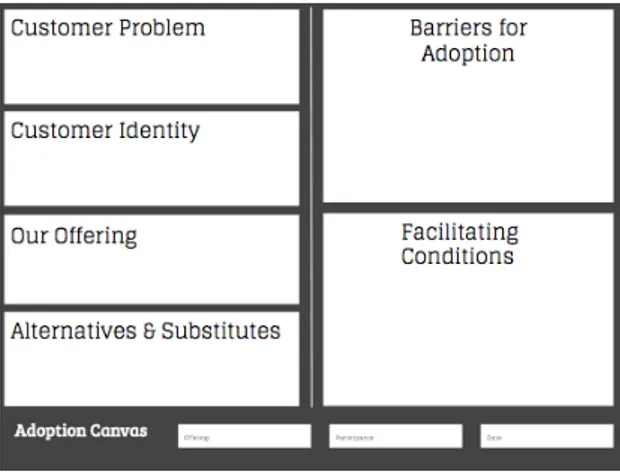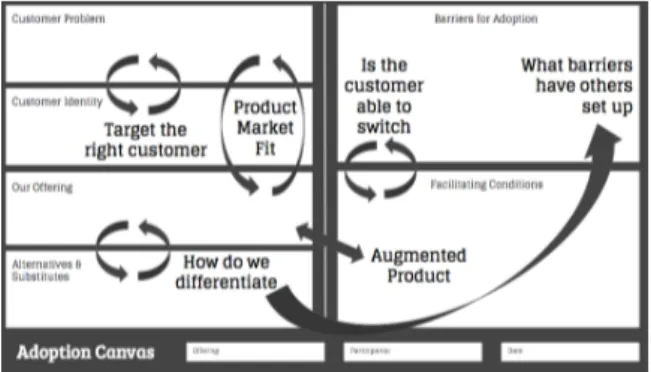1
Taking Innovative Products to the Market
Development of a Working Model for Adoption
in Collaboration with Sony Mobile Communications
Hampus Pettersson & Kristina Hedin 2016-05-23
Department of Production Management The Faculty of Engineering, Lund University
In the fast changing business environment today many companies struggle with developing new products or services that succeed to bring value to customers. Short product life cycles demand effective product development, and knowing which customers will adopt an innovation, and developing innovations around them is now more important than ever. Today there are many procedures of work when taking innovations to the market. Business models are helpful to use when developing and taking new products or services to the market. A master thesis project generated a model that can be used for gaining insights about possibilities and risks when taking new products to the market. This article presents the Adoption Canvas - a model for gaining traction of innovative products.
Introduction
Business models are a statement of how value is created and captured. There are many different types of models, all of them trying to serve the purpose of guiding academics and managers to the understanding of value creation and value capture. (Baden-Fuller, 2015) Value is captured when an innovation is adopted by the market. Adoption of technology is defined as the stage of selecting a technology for use by an individual or an organization. (Carr, 2008) But how can an organization know if their innovative product will be adopted by the market, and who will adopt it? The Adoption Canvas is a model to use for gaining insights about the whole augmented product. The insights involve possibilities and risks regarding adoption of the new solution. By answering a number of questions designed from adoption literature, the practitioner will find pitfalls with the current solution and develop the innovation to ease the adoption of it. The Adoption Canvas is the outcome of a master thesis by Kristina Hedin and Hampus Pettersson in collaboration with Sony Mobile Communications in Lund.
Methodology
The Adoption Canvas was developed through an extensive literature research focusing on adoption. The literature research covered innovation management when developing new solutions and different studies performed on adoption for discovering which factors play an important role for gaining traction. A number of models and factors found to affect adoption were chosen as a base for the model that became the Adoption Canvas. Interviews were performed to gather data from employees at the company Sony Mobile Communications. Seven interviews were performed to explore the employees’ perceptions of which factors are important to consider regarding adoption of innovations. In order to validate the Adoption Canvas, and further develop it, observations were done in which representatives from three different companies tested the Adoption Canvas on their own products. The main company, where four observation sessions were held was Sony Mobile Communications. The other companies taking part in observations were Haldex and Höganäs. The observation sessions provided the authors with practical feedback on how the
2 Adoption Canvas was received by users, what
gains it provided the practitioners with and what drawbacks the model had. The representatives who tested the canvas gave the authors valuable feedback for the development of the canvas to its final version.
Theory
The Adoption Canvas was developed through an extensive literature research of articles and books regarding adoption. The literature research provided the students with qualitative data to base the model upon.
Important theoretical frameworks and models used for developing the model are the Unified Theory of Acceptance and Use of Technology model (UTAUT) (Venkatesh, 2003), the Value Proposition Canvas (VPC) (Osterwalder et al. 2014) and Fogg’s Motivation Ability Triggers behavior model (MAT behavior model) (Fogg, 2009). Important factors for adoption used are switching cost, and customer tribes.
The UTAUT model describes how the four factors, performance expectancy, effort expectancy, facilitating conditions and social influence affect a specific behavior. These four factors are also key determinants in order to reach adoption. (Venkatesh, 2003)
The VPC is a model with which the practitioner creates a customer profile and a value map. The customer profile defines the customer, and the value map defines the new solution. When these two parts are connected the practitioner obtains a product-market-fit. (Osterwalder et al. 2014) This is pictured in Figure 1.
Figure 1: The two elements in the VPC model: Value Map and the Customer Profile. Figure developed from page 8-9 in (Osterwalder et al. 2014).
The MAT behavior model states that the three elements motivation, ability and triggers need to co-exist for a specific behavior to occur. (Fogg, 2009) The potential adopter of an innovation has to be motivated and able to use the new solution to adopt. There is a trade off relationship between motivation and ability. This is illustrated in Figure 2.
Figure 2: Picturing the relationship between Motivation and Ability in the MAT model. Figure developed from Figure 1 in (Fogg 2009).
Development of the Model
The development of the model was divided into two phases.
The first phase started with interviewing people with different responsibilities and background at Sony Mobile Communications. This was an active choice to interview people from different backgrounds to gain an understanding of more than one perspective from the employees at Sony. The outcome from the interviews was that the project was narrowed down to only focus on adoption.
3 In the literature research focused on adoption a
gap in the literature was detected between theoretical models and working models for adoption. In an attempt to fill this gap the first outline of the Adoption Canvas was developed.
Phase 2 was about validating the model, and as described in the methodology section, the model was tested during six observation sessions with employees with different roles and responsibilities from different companies. The model was then refined and the final Adoption Canvas is presented in the next section.
Results
The Adoption Canvas is comprised of six entry blocks with different topics, each containing questions for the practitioner to answer. The purpose of using the Adoption Canvas is for the practitioner to gain insights about the augmented product/ service/ concept developed and how it can be accepted and used by the target customer. The model is successfully tested six times on three different companies from different industries. It is believed to give most insight for the practitioner if the canvas is used early in the product/ service/ concept development process when developing and actualizing an idea. The Adoption Canvas is visualized in Figure 3.
Figure 3: The Adoption Canvas.
The titles of the entry blocks are Customer Problem, Customer Identity, Our Offering,
Alternatives & Substitutes, Barriers for Adoption and Facilitating Conditions. The Customer Problem entry block defines the problem that the customer needs solving. The Customer Identity entry block identifies the customer tribe that should be targeted. Our Offering Entry block describes the solution offering, and this should solve the problems in the entry block Customer Problem. The Alternatives & Substitutes entry block states what other alternatives exist that the competitors have created. It also states what substitutes exist, meaning what the customer uses to solve their problems without the new solution. Barriers for Adoption entry block helps the practitioner identify possible hinders for adoption that the potential adopters might have. The practitioner can then develop supportive services in the Facilitating Conditioner entry block to overcome the barriers for adoption and ease the switch to, and the use of the new offering.
The entry blocks are connected together in different ways to contribute to the holistic view of the augmented product regarding adoption. The Customer Problem and Customer Identity entry blocks together help the practitioner identify and specify the customer segment. The entry block Our Offering is connected to the Customer Problem to create a product-market fit, derived from the VPC model. The entry block Out Offering is connected to Alternatives & Substitutes in the sense that the practitioner gains realizations about how the own offering differentiates from the competing solutions. The entry block Alternatives & Substitutes is connected to Barriers for Adoption so that the practitioner gains insights about the barriers for adoption that the competitors have set up. The Barriers for Adoption entry block has a strong connection to the Facilitating Conditions entry block. The hinders for adoption detected in the Barriers for Adoption entry block are overcome by developing supportive services in the Facilitating Conditions entry block, simplifying the switch
4 for the customer. Lastly, the Facilitating
Condition entry block is connected to the Our Offering entry block in the sense that the augmented product is these two blocks combined. The connection between entry blocks can be seen in Figure 4.
Figure 4: The Adoption Canvas and its important connections between entry blocks.
The Adoption Canvas can be used standalone to get an overview of the adoption risks and possibilities. However, it also works well as a complement to other tools and models such as the Business Model Canvas (Osterwalder et al. 2010), the Value Proposition Canvas (Osterwalder et al. 2014) and other data.
References
Baden-Fuller, C. and Mangematin, V. (2015) Business Models and Modelling Business Models. Emerald Press: Advances in Strategic Management
Carr Jr, V.H. (2008) Technology Adoption and Diffusion. The Learning Center for Interactive Technology
Fogg B.J. (2009) A Behavior Model for Persuasive Design. Persuasive 2009; 4th International Conference on Persuasive Technology
Osterwalder, Alexander and Pigneur, Yves, (2010) Business Model Generation, A Handbook for Visionaries, Games Changers and Challengers. John Wiley & Sons, Inc Hoboken, New Jersey
Osterwalder, A and Pigneur, Yves and Bernarda, G and Smith, A, (2014) Value Proposition Design. John Wiley & Sons, Inc., Hoboken, New Jersey
Venkatesh, V. and Morris, M.G. and Davis, G.B. and Davis, F.D. (2003) User Acceptance of Information Technology: Toward a Unified View. Management of Information Systems Research Center, University of Minnesota: MIS Quarterly


